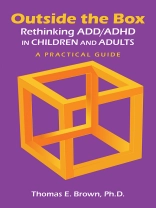Outside the Box: Rethinking ADD/ADHD in Children and Adults — A Practical Guide identifies assumptions about ADD/ADHD that demand reevaluation in light of recent research. Building upon a current, science-based foundation, the book describes in practical terms how ADHD can be recognized at various ages; how it differs from more typical brain development; how it can significantly impair those affected; and how it can safely, and in most cases effectively, be treated in children and adults. The book is based upon current scientific research but also on the experience and perspective of the author, a clinician who has devoted more than 35 years to studying this disorder formally and countless hours to engaging with and providing treatment for a diversity of children, teenagers, and adults with ADHD and related problems. The book’s audience is the wide variety of clinicians involved in assessing, treating, and/or monitoring the care of children and adults with this disorder (e.g., pediatricians, primary care physicians, psychologists, psychiatrists, neurologists, physician assistants, advanced practice nurses, and clinical social workers) and also educators, disability service providers, human resource specialists, and the adolescents and adults who seek more information about ADHD assessment and treatment for themselves or for family or friends.
The book offers practical, accessible information that is grounded in the latest research: The book is focused not primarily on details of academic arguments but on practical aspects of ADHD — how it varies from one person to another, how it changes over the life span, how treatments need to be adjusted for different individuals, and how it sometimes gets worse and sometimes gets better. Emphasizing that ADHD is not a simple problem of failing to listen or staying focused on a task, the author examines research demonstrating that ADHD results from impairment of a complex syndrome of brain functions essential for self-management, the ’executive functions.’ While DSM-5 is acknowledged as a valuable source of information about ADHD, this book draws upon a wider range of scientific research and perspectives not yet incorporated into DSM. Although accessible to the general reader, the text includes citations to sources that can be used to obtain additional, more technical information.
Utterly current and scientifically based, Outside the Box: Rethinking ADD/ADHD in Children and Adults — A Practical Guide challenges old thinking and provides much-needed information and support to clinicians, educators, patients, and families.
Innehållsförteckning
Preface About the Author Introduction Chapter 1. Basic Facts and the Central Mystery of ADHDChapter 2. A New Model of ADHD: Executive Function Impairments Chapter 3. Differences Among Persons With ADHDChapter 4. Ways ADHD Can Impair Functioning at Various Age Levels Chapter 5. How ADHD Impacts ’Brain Googling’ for Motivations Chapter 6. How ADHD Develops, Sometimes Gets Worse, and Sometimes Improves Chapter 7. How and Why Other Disorders Often Co-Occur With ADHDChapter 8. Assessing Children, Teenagers, and Adults for ADHDChapter 9. Emotional Dynamics in Individuals, Couples, and Families Coping With ADHDChapter 10. Practical Aspects of Medication Treatments for ADHDChapter 11. Practical Aspects of Nonmedication Interventions for ADHDChapter 12. Treatment Adaptations for ADHD With Various Complications References Index
Om författaren
Thomas E. Brown, Ph.D., is a clinical psychologist who received his Ph.D. from Yale University and is Director of the Brown Clinic for Attention and Related Disorders in Manhattan Beach, California.












